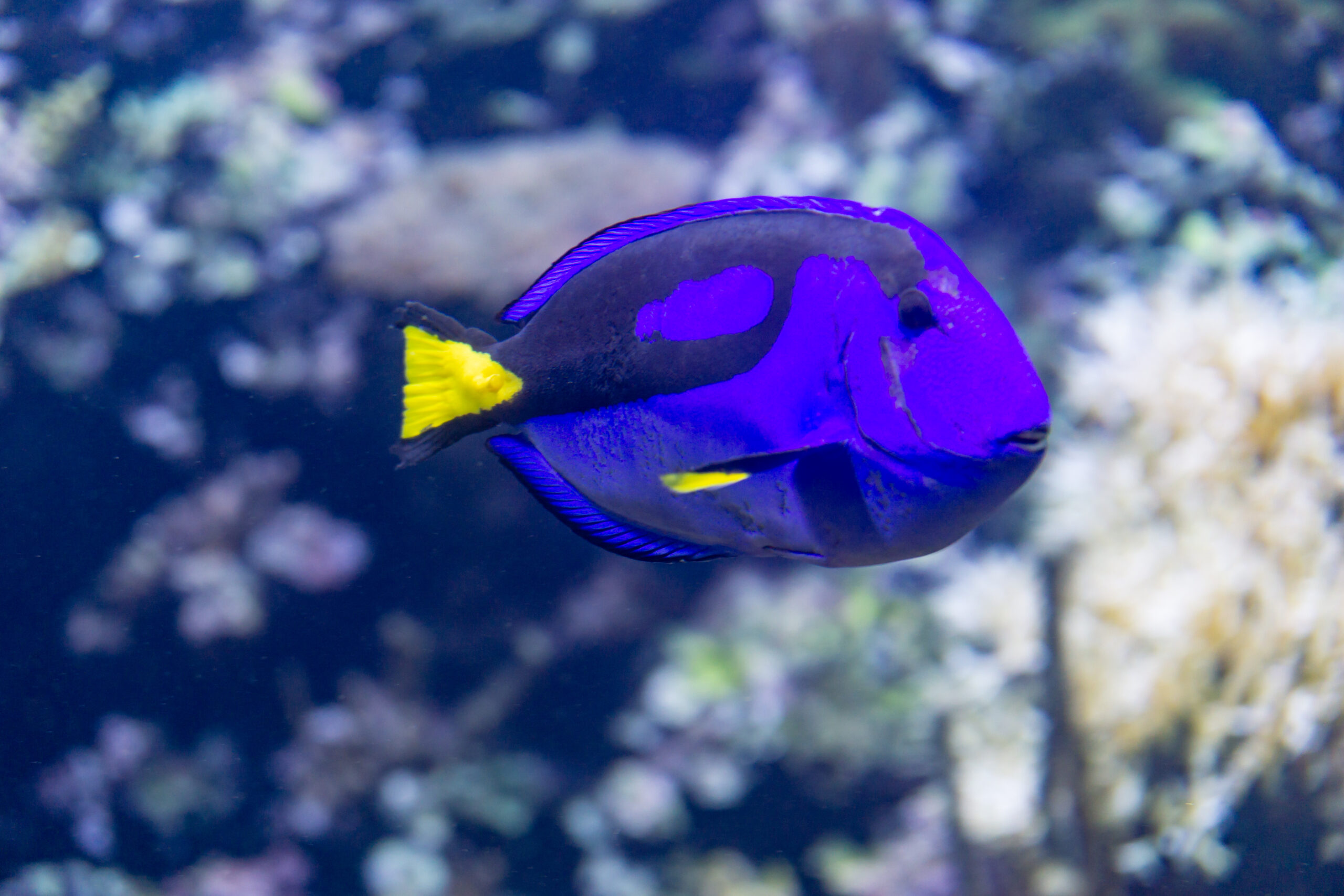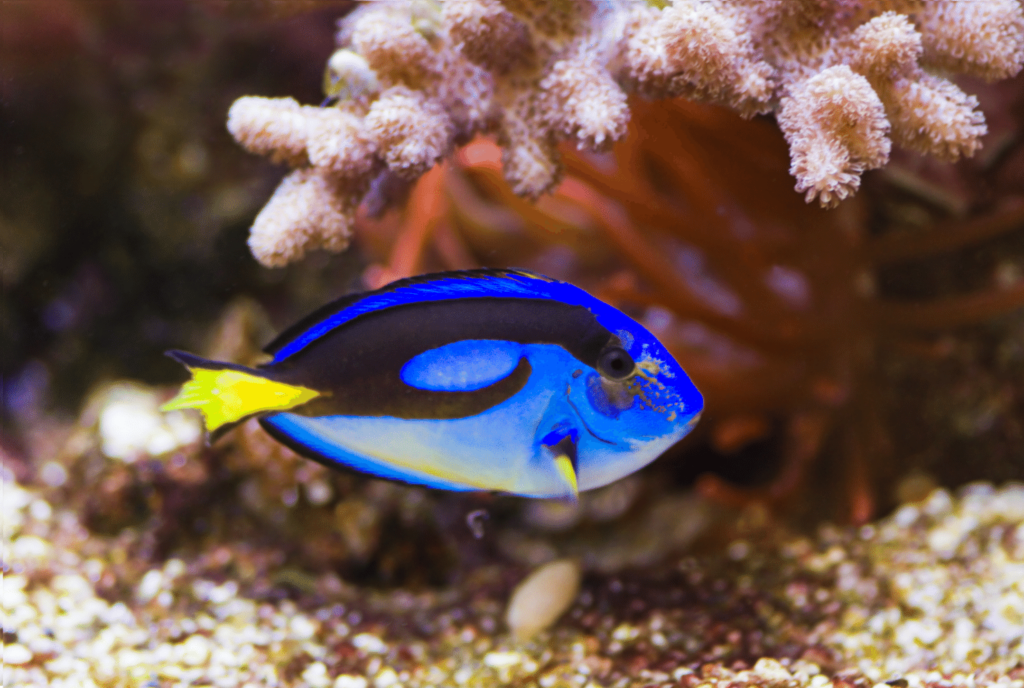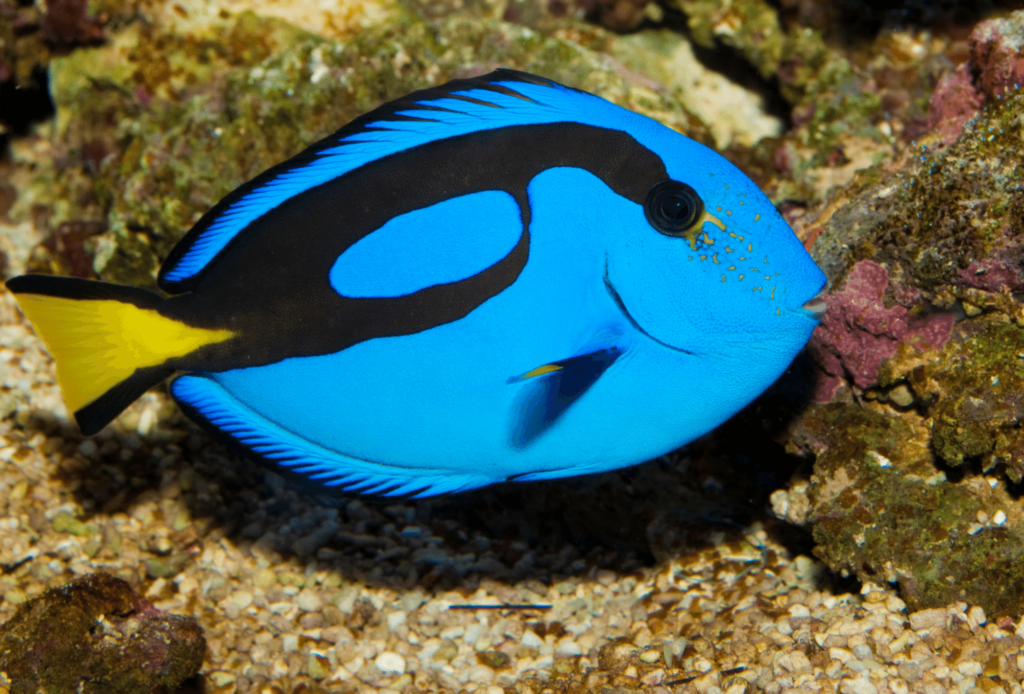Your cart is currently empty!

A Beginner’s Guide to Blue Hippo Tang: From Selection to Daily Care
The Blue Hippo Tang, also known as the Regal Tang, Pacific Blue Tang, or Palette Surgeonfish, is a stunning addition to any saltwater aquarium. Known for their vibrant blue bodies and yellow tails, these fish are both visually striking and somewhat challenging to care for.
This comprehensive guide covers everything you need to know about selecting, acclimating, and maintaining a healthy environment for your Blue Hippo Tang.
Understanding Blue Hippo Tang

Blue Hippo Tangs (Paracanthurus hepatus) are native to the Indo-Pacific region, including Fiji, Indonesia, and the Maldives. They are known for their striking blue color, black ‘palette’ design on their sides, and bright yellow tails. These fish can grow up to 12 inches in length and typically live for 7-10 years in captivity with proper care.
When choosing a Blue Hippo Tang, look for active, brightly colored fish without visible signs of disease, such as white spots (indicative of ich) or frayed fins. Ensure the fish is eating well and behaving normally. It’s best to purchase from reputable dealers who can provide information on the fish’s health and origin.
Setting Up the Aquarium
Setting up an aquarium for a Blue Hippo Tang requires careful planning and attention to detail to create a healthy and suitable environment. Here is a step-by-step guide to help you set up the aquarium:
Tank Requirements
Blue Hippo Tangs require a spacious tank, with a minimum size of 180 gallons recommended for a single adult fish. They thrive in tanks with plenty of live rock for hiding and grazing. The water temperature should be kept between 75°F and 79°F, with a pH level between 8.1 and 8.4, and specific gravity between 1.020 and 1.025. Regular water changes and a strong filtration system are crucial to maintaining water quality.
Equipment Needed
Ensure your tank is equipped with a reliable filtration system, protein skimmer, and adequate lighting. Live rock is essential as it provides natural grazing spots and hiding places to reduce stress. Pumps and filters should be cleaned regularly, and at least 20% of the tank water should be replaced weekly to maintain optimal water conditions.
Introducing Your Blue Hippo Tang to the Tank
Before introducing your Blue Hippo Tang to the main tank, quarantine the fish for at least two weeks in a separate tank. This helps prevent the introduction of parasites and diseases to your established aquarium. During quarantine, monitor the fish for any signs of illness and ensure it is eating well.
Acclimate your new tang slowly to avoid shock. This can be done by floating the bag in your tank for about 15-20 minutes to equalize temperature, followed by slowly adding small amounts of tank water to the bag over the next hour. Using a plastic container for transfer is less stressful than using a net.
Daily Care and Maintenance
Proper care and maintenance are essential to ensure their health and well-being. Here are the daily care and maintenance guidelines:
Feeding Your Blue Hippo Tang
Blue Hippo Tangs are primarily herbivores, feeding on marine algae and seaweed. Provide a varied diet including dried seaweed sheets, herbivore pellets, and frozen or fresh marine algae. Feed them small amounts two to three times a day to mimic their natural grazing behaviour. Using a seaweed clip or feeding station can help simulate their natural feeding environment.
Regular Tank Maintenance
Maintain pristine water conditions through regular water changes (20% weekly) and frequent cleaning of the filtration system. Monitor water parameters regularly to ensure stability. Keeping the water clean and stable is essential to prevent diseases and promote the health of your Blue Hippo Tang.
Monitoring Fish Health
Keep an eye out for signs of common diseases such as ich and marine velvet. Symptoms include white spots, a velvety appearance on the skin, and rapid weight loss. Quarantine new arrivals and treat any infections promptly. Maintaining high water quality and a stress-free environment is key to preventing health issues.
Social Behavior and Tank Mates
Blue Hippo Tangs are generally peaceful but can be territorial. They are best kept with other non-aggressive fish like gobies, clownfish, and groupers. Avoid keeping them with aggressive species that may bully them.
If keeping multiple tangs, introduce them simultaneously to minimize territorial disputes and ensure ample space. Blue Hippo Tangs can be kept in pairs or schools if the tank is large enough to accommodate their active swimming needs.
Troubleshooting Common Issues
Here are some troubleshooting tips to help you address these issues:
1. Ich (White Spot Disease)
Ich is a common issue with all kinds of saltwater fish, including blue hippo tangs. It presents itself as small white spots on the fish’s body and can lead to serious health problems if not treated promptly. To combat ich, you can try raising the temperature of the tank slightly (but not too high) and adding an ich treatment medication as recommended by your local pet store or aquarium expert.
2. Fin Rot
Fin rot is another common issue that can affect blue hippo tangs. This bacterial infection causes the fins and tail of the fish to deteriorate, leaving them susceptible to other infections. To treat fin rot, remove any sick fish from the tank and treat the affected area with a bacterial medication. Keep a close eye on water quality and make sure the tank is clean to prevent future outbreaks.
3. Aggression towards Tankmates
Blue hippo tangs are known to be territorial and can exhibit aggressive behavior towards other fish in the tank. If you notice your blue hippo tang bullying or attacking other tankmates, it may be best to remove the fish from the tank and place them in a separate quarantine tank to prevent further harm. Consider rearranging tank decorations to create new territories and reduce aggression.
4. Poor Water Quality
Poor water quality can lead to a host of issues for blue hippo tangs, including stress, disease, and even death. Make sure to regularly test the water parameters in your tank, including pH, ammonia, nitrites, and nitrates, and perform water changes as needed to maintain stable conditions. Investing in a quality filtration system can also help improve water quality and keep your fish healthy.

Dive into Luxury and Marine Wonder Today!
Caring for a Blue Hippo Tang requires commitment and attention to detail, but the reward is a vibrant, active fish that adds beauty and interest to your aquarium. By following this guide, you can create a healthy, thriving environment for your Blue Hippo Tang, ensuring it remains a stunning centrepiece in your underwater world.
Are you ready to discover the extraordinary? At Diamonds by Raymond Lee’s in-store aquarium, luxury meets marine wonder. Explore breathtaking tanks with awe-inspiring sharks, vibrant coral reefs, and graceful stingrays.
Join us for live feedings and unique daily experiences. Plus, dive deeper into marine science with our expert-led tours and interactive displays. Visit us today and embark on a journey of luxury and exploration!
